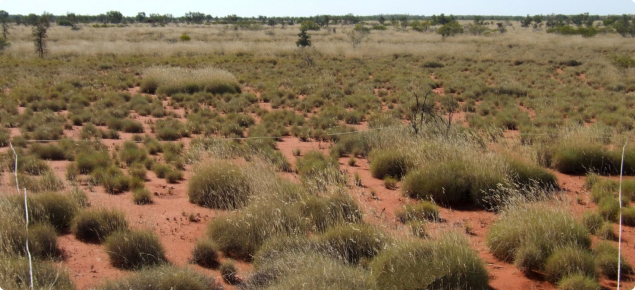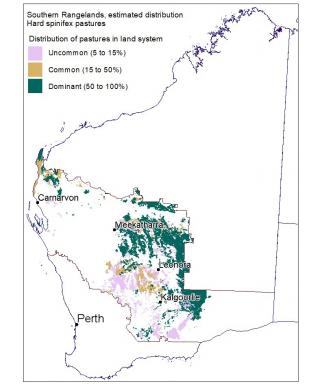Pastoral potential – low to very low
The pastoral value of the hard spinifex pastures is low to nil – unless recently burnt, when germination of some palatable grasses and herbs is stimulated. See managing hard spinifex pastures below.
Suggested levels of use (per annum)
Table 1 provides a rough guide to the range of pastoral values for good condition pastures, which must be checked against conditions in each region and paddock. Carrying capacities for fair condition pastures might be 75% to 50% of good, and poor condition pastures less than 50% of good.
See Introduction to pastures in the southern rangelands of Western Australia for an explanation of how carrying capacities are estimated. Carrying capacity expressed as 140–209/>210 is low/very low.
| Condition | Carrying capacity ha/DSE1 | Carrying capacity ha/CU2 (ha/AE3) |
|---|---|---|
| Good | 20–29.9/>30 | 140–209 to ≥210 (168–251 to ≥252) |
1 DSE is based on the feed energy required to maintain a 45 kilogram liveweight Merino wether with zero weight change, no wool growth additional to that included in maintenance, and walking 7 km/day. 1 DSE has an energy requirement of approximately 8.7 MJ ME/day.
2 CU in the southern rangelands is based on a 400 kg steer at maintenance and equivalent to 7 DSE.
3 AE is based on the feed energy to maintain a 450 kg Bos taurus steer 2.25 years of age, walking 7 kilometers each day. 1 AE has an energy requirement of approximately 73 MJ ME/day and equivalent to 8.4 DSE.
Managing hard spinifex pastures in the southern rangelands
Post-fire grazing should be deferred for at least eight weeks after opening rains. Spinifex country’s greatest value for herbivores is about a year after fire and subsequent rain, when diverse short-lived grasses and woody herbs become established. The short-lived plants gradually decline in abundance and diversity as spinifex regains dominance after about five to seven years. Spinifex will continue to increase in dominance and inhibit other plant species establishment from about five years post-fire, incrementally increasing the fuel load until the next fire event.
Spinifex seedlings in good condition pastures establish readily after one post-fire growing season, but cover remains low for one or two seasons. Perennial shrubs emerge as pioneers with spinifex, forming a much larger suite of species than in the climax community. As such a stand matures, it is often classified as a shrubland and PFC of the shrub component may reach 25% or more. As the climax state approaches (10 to 15 years after fire) the hummock grassland form will be resumed as the shrub component diminishes through senescence or competition and crowding by spinifex (Suijdendorp 1967).
Hard spinifex pastures are usually very stable, but wind erosion can occur on recently burnt areas which have yet to stabilise with seasonal growth.
Pasture condition
Survey data show that hard spinifex pastures in the southern rangelands are predominantly in good condition.
Good
See Figures 1, 2. There is an even coverage of hard spinifex plants. A few palatable perennial grasses (e.g. broad leaf wanderrie, soft spinifex, feather speargrass) may occur in low numbers between spinifex hummocks but will tend to be concentrated on drainage lines and under trees. Variable cover of relatively palatable intermediate value annuals such as wind grass may be found for a short time following a good growing season.
Fair
See Figure 3. Hard spinifex is generally ignored by stock, so it is mainly the in-between species that cattle will graze when on these pastures. For this reason, a decline from good towards fair condition is usually accompanied by a reduction in numbers and vigour of palatable grasses. The coverage of spinifex plants may appear patchier or uneven and areas supporting only a sparse cover of annuals and undesirable perennial plants (e.g. cassias) may be present. Poor post-fire grazing management can increase the uneven appearance of these pastures.
Poor
Larger bare patches may be present where perennial plant re-establishment no longer occurs. Palatable companion grasses lack vigour or are absent. Those non-spinifex species that are present tend to be undesirable cassias and annuals with low fodder value. The abundance of annual grasses depends on the season.
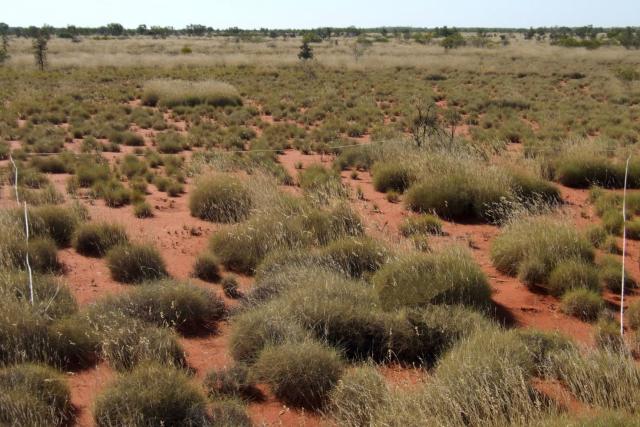
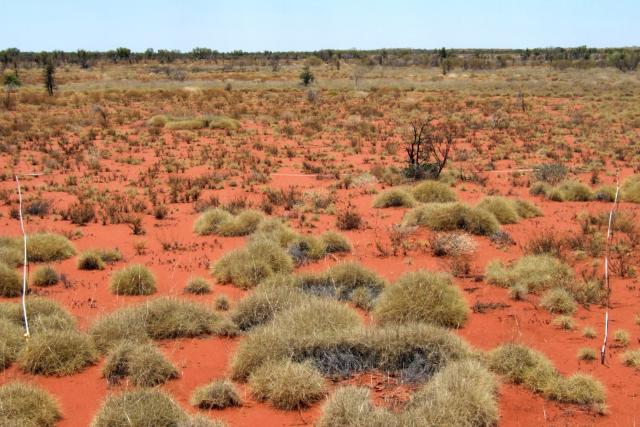
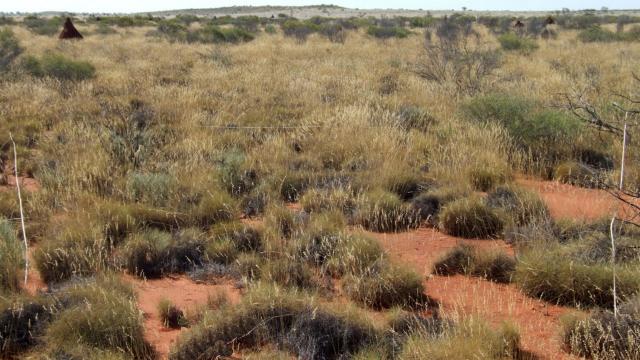
Vegetation structure and composition
Hard spinifex pastures are predominantly hummock grasslands, with spinifex dominating the vegetation to the near exclusion of other ground layer species. The dominant type of spinifex (Triodia species) varies according to regional distribution. A variable overstorey of trees and tall shrubs including mallee eucalypts, marble gum, gidgee or spreading gidgee may be present. These pastures are sometimes tall (>2 m) or low (<2 m) shrublands over hummock grasses, with some such as those in the Murchison River catchment having only a sparse cover of spinifex between tall shrub or mallee clumps.
Projected foliar cover (PFC) varies between zero and more than 50%; depending on the fire history. Typically old hard spinifex stands have a high PFC and low moisture content within the foliage. Fire often kills senescent stands and may totally remove all groundcover.
The composition of the upper stratum within hard spinifex pastures is variable and generally very scattered. A wide range of low shrubs occurs and the most diverse stands are associated with early post-fire successional stages. The densities of individual upper-canopy species rarely exceed 1500 plants per hectare. Locally important desirable perennial grasses also occur. Broad leaf wanderrie grass, feather speargrass and buffel grass are occasionally present. Annual grasses and forbs may be present in good seasons for a few years after fire.
Occurrence
Hard spinifex pastures dominate large areas of infertile red sandy soils, covering an estimated 7.76 million hectares (9.6% of the southern rangelands). They occur in arid areas of the eastern Goldfields, parts of the Gascoyne and Ashburton, Sandstone-Yalgoo – Paynes Find area and minor parts of the Murchison River catchment, southern Goldfields and Nullarbor. Very extensive areas also occur in the Pilbara and Kimberley. Hard spinifex pastures can occur on hills and stony plains but in the southern rangelands they mostly occur on sandplains.
Associated plants
| Common name | Scientific name | Desirability* |
|---|---|---|
| Bluebushes | Maireana spp. | D |
| Broad leaf wanderrie grass | D | |
| Buffel grass | D | |
| Camel weed | Scaevola sp. | D |
| Cotton bush | D | |
| Currant bush | D | |
| Feather speargrass | D | |
| Hop-along grass | D | |
| Oat-eared spinifex | D | |
| Soft spinifex | D | |
| Tall saltbush | D | |
| Tar bush, fuchsia bush | D | |
| Warty-leaf eremophila | D | |
| Woollybutt grass | D | |
| Bloodbush | U | |
| Crinkle leaf cassia | U | |
| Bowgada, wanyu, horse mulga | I | |
| Buck wanderrie grass | I | |
| Flannel bush | I | |
| Giant grey spinifex | I | |
| Gidgee, yalardy | I | |
| Greybeard grass | I | |
| Poverty wattle | I | |
| Spreading gidgee | I | |
| Sugar brother | I | |
| Wilcox bush | I | |
| Wind grass | I | |
| Buck spinifex | N | |
| Grevillea | Grevillea spp. | N |
| Heath-myrtle | N | |
| Kingsmill's mallee | N | |
| Limestone spinifex | N | |
| Low paperbark | N | |
| Marble gum | N | |
| Native mints | Prostanthera spp. | N |
| Porcupine spinifex | N | |
| Hard spinifex | N | |
| Hard spinifex | N | |
| Spinifex | N | |
| Spinifex | N | |
| Spinifex | N | |
| Spinifex | N | |
| Spinifex | N | |
| Spinifex | N | |
| Victoria Desert mallee | N |
* D = desirable, U = undesirable, I = intermediate, N = no indicator value

